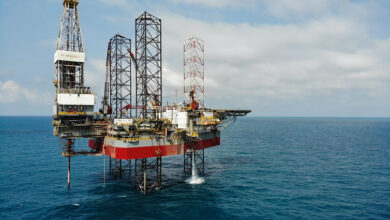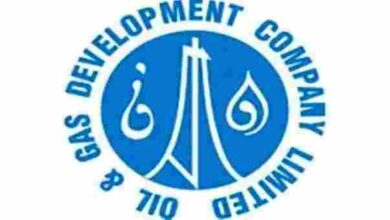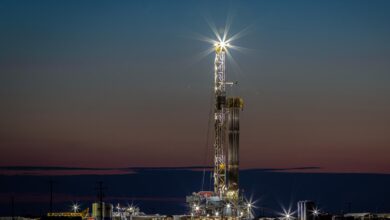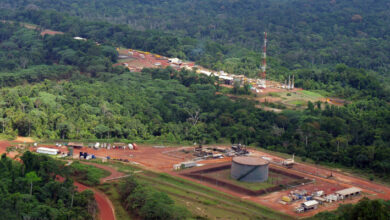International onshore rig demand to see slow recovery through 2025
Near-term outlook characterized by cautious optimism, with China, Russia and Middle East expected to drive bulk of growth in rig and well counts out to 2025
By Stephen Whitfield, Associate Editor
The past two years have been tough for the international onshore land drilling market, from Asia Pacific to Europe to the Middle East to Latin America. Going into 2022 and looking out to 2025, however, things are looking up, according to Westwood Global Energy Group’s 2021 World Land Drilling Market Forecast. The firm is forecasting increases in most relevant metrics, including rig count, utilization rate and number of wells drilled.
By 2025, Westwood expects operators will be drilling an estimated 50,200 onshore wells globally, up from just 38,500 in 2020 and approaching the 52,000 wells drilled in 2019. This is expected to drive global land rig demand up to 4,560 rigs by 2025. That’s a nearly 30% increase compared with a demand of 3,530 rigs in 2021 and nearly matching the 4,570-rig demand level seen in 2019.
At the same time, total rig supply is expected to remain flat, at around 9,000, through 2025. This sets the scene for improvements in utilization rates, which is forecast to improve from 39% in 2020 to 50% in 2025.
Looking at specific markets, the Asia Pacific and Eastern Europe/Former Soviet Union (FSU) regions are expected to be the primary drivers in demand growth for land rigs over the next four years. Westwood projects an estimated annual average of 1,430 operational rigs, defined as rigs either drilling or in the process of mobilizing to a field, in Asia Pacific from 2021-2025. This is more than any other region in the group’s analysis. Eastern Europe/FSU is estimated to average 1,130 rigs over the same time period, followed by North America at 890, the Middle East and North Africa (MENA) region at 560, Latin America at 170, Sub-Saharan Africa at 30 and Western Europe at 10.
In terms of the broader oil and gas markets, supply and demand is expected to remain tightly balanced over the remainder of 2021 and into 2022, according to Westwood. However, the uncertainty of pandemic-induced demand shocks will likely continue to loom large for years to come, keeping a ceiling on any upside in commodity prices and leading E&P companies to maintain their focus on capital discipline. While Brent had risen above $78/bbl as of 30 September, Westwood’s rig demand forecast is underpinned by an assumption of $60/bbl in its base case scenario for 2022-2025.
“When we look to the forecast, we aren’t really expecting a quick return to activity globally,” Ben Wilby, Senior Analyst, Onshore Energy Services at Westwood, said. “We’re expecting quite a slow, measured increase. Operators are going to remain cautious and selective with the drilling programs that they progress. That’s particularly the case for those companies who are focusing on profitability and shareholder returns as opposed to maximizing production.”
Asia Pacific
Not only is the Asia Pacific region forecasted to have the highest land rig demand from 2022-2025, but it will also have the highest rig utilization rate, at around 66%. China will make up the bulk of rig activity in this region. Westwood estimates the current number of operational land rigs in China at around 1,100, with a total rig supply of 1,500. Those figures should rise to 1,300 rigs operating out of a 1,600-rig fleet by 2025. NOCs China National Petroleum Company (CNPC) and Sinopec currently account for 95% of the identified rigs within the country, and that number is not expected to change significantly through 2025.
However, there could be rapid changes in the makeup of the Chinese land rig fleet in the coming years, as the country ramps up development of its unconventional resources. Currently, China has a smaller share of high-horsepower rigs compared with other regions measured in Westwood’s report. Of the 1,500 rigs there now, only 51% are high-horsepower (greater than 1,499 hp), while 36% are medium horsepower (1,000-1,499 hp) and 13% are low horsepower (less than 1,000 hp). As a comparison, 87% of operational rigs in MENA and 79% in North America are high-horsepower rigs.
“The development of unconventional resources is central to our forecasts for China,” Mr Wilby said. “After 2014, there was a significant contraction in drilling activity, and the maturity of plays and lower oil prices were disincentivizing drilling. But, since they hit a low point in 2016, the government has made increasing that domestic production a focus.”
Land rig utilization in China is expected to reach 80% by 2025, well above the global average of 50%, Mr Wilby said. The increase will be driven primarily by government mandates to increase domestic production, particularly in its unconventional sector. China’s latest Five Year Plan, released in February, specifically cited unconventional E&P as part of its efforts to reduce reliance on oil imports. In March, the country’s Ministry of Finance and the State Administration of Taxation also extended its 30% tax deduction for shale gas producers through 2023.
Since then, China’s NOCs already have outlined major projects to boost production from its unconventional fields.
On 25 August, CNPC announced plans to produce an annual average of 200,000 bbl/day of shale oil from the Gulong formation in the Daqing field in northeast China; production startup is expected by 2025. Sinopec also said it estimates a 2 billion cu m/year boost in natural gas production capacity from its Weirong shale gas field, once it begins Phase II of development next year. The field, located in the Sichuan Basin in southwestern China, currently has an annual production capacity of 1 billion cu m/year. Phase I, which involved the drilling of 56 wells from eight pads, began in late 2019 and ended in January 2021.
“Countries who have strong government mandates to increase activity are likely to see the greatest level of demand, and China is probably the key example of that,” Mr Wilby said. “There is quite a lot of upside potential in China. Should companies progress those shale developments faster than we anticipate – and it has to be said there remains relatively limited experience there, and there are concerns over infrastructure – there is the potential for activity in China to rapidly increase.”
Outside of China, India and Australia are other areas of note in the Asia Pacific region. India is expected to go from 85 rigs operating and 45% utilization in 2021 to 110 rigs and 60% utilization in 2025. The number of wells drilled is forecast to average 500-600 per year over that same time frame. Westwood said it is optimistic about the growth potential in India primarily because the country has set “ambitious” production targets. In 2019, ONGC announced a goal of doubling its production by 2040. This will likely lead the NOC to be more aggressive in farming out marginal fields to other companies to help build production.
For Australia, which is still dealing with stringent travel restrictions related to the COVID-19 pandemic, Westwood’s outlook is more conservative. The forecast calls for rig count to go up from 25 in 2021 to 30 in 2025 and for wells drilled to go up from 540 in 610 in the same time span. Rig utilization rate will average 24% over the next four years. Those numbers are roughly similar to the country’s averages from 2016-2020.
However, the country could still see a boost in gas production later this decade. Noting the high costs of offshore gas projects in Australia, Mr Wilby said the government may potentially push for more unconventional gas developments to help avoid a potential gas shortfall. These developments will likely come from smaller operators like Tamboran Resources. In June, the company announced plans to develop the Beetaloo shale basin in the Northern Territory and begin production by 2025.
Europe
In Eastern Europe/FSU, drilling activity will continue to be dominated by Russia. To meet export commitments, the country will need to sustain high levels of drilling on its mature fields. From 2021-2025, Russia is expected to average 1,000 rigs in operation and to drill 6,400 wells annually, making up around 88% of the region’s total expected rig count of 1,130 and 7,300 well count total. Rig utilization in the country is expected to average 70%. As in China, much of Russia’s drilling activity is expected to come from its NOCs.
Aside from Russia, Westwood also pointed to Kazakhstan as a country of note. While activity is on a much smaller scale than in Russia, rig demand in Kazakhstan is expected to double from 25 rigs in 2021 to 50 rigs in 2025. This growth is due, in large part, to Chevron’s planned expansion of the Tengiz field in the northwestern part of the country. The $45 billion expansion, which Chevron is set to finish in 2024, will boost the field’s oil production by 260,000 bbl/day and gas production capacity by 960 million cu ft/day.
Western Europe will be much less of a factor in the global land drilling mix. Westwood estimates the region to average just 10 rigs a year and 76 wells drilled from 2021 to 2025, with rig utilization at approximately 10%.
The challenge in this region is two-fold, Mr Wilby said. First, the reservoirs that are typically being developed are in mature fields that have been in production for a long time, and the remaining reserves are much smaller compared with what can be found in other parts of the world.
Second, the regulatory environment is not favorable to land drilling. Hydraulic fracturing has been banned in many Western European countries, including France, Germany and The Netherlands. In general, drilling activity typically meets “fierce resistance,” Mr Wilby said. “The reservoirs in Western Europe aren’t the kind of prize that they would be if you were drilling in, say, the Middle East. When you combine that with very strict regulatory requirements, the region is typically less investment friendly than other areas.”
Middle East and North Africa
In the MENA region, the Gulf Cooperation Council (GCC) states are expected to drive the bulk of land drilling activity in the coming years. Rig demand here is forecasted to increase from 300 in 2021 to 380 in 2025, with utilization increasing from 55% to 70% in the same time period. Total wells drilled is expected to increase from 2,000 this year to around 2,500 by 2025.
Of the six countries in the GCC, Mr Wilby said, it will be Kuwait, Oman and Saudi Arabia that have the most potential for “significant” increases in onshore rig demand. This presumes that OPEC+ follows through on its plan, announced this summer, to end production cuts by September 2022. The cuts were enacted in 2020 following the oil price downturn.
In Saudi Arabia specifically, Westwood expects to see a significant boost in activity. The country is forecast to see a demand for 150 land rigs by 2025, a 36% increase over 2021 levels. However, the bulk of that increase will likely not come until after 2022, according to Westwood. This is partly due to the timing of the OPEC+ cuts ending, but Mr Wilby also noted the projected 2024 startup of production at Jafurah, the largest natural gas field in the country, with an estimated 200 trillion cu ft of reserves.
“Saudi Arabia is on a drive to increase natural gas production, both with the associated gas from major oil fields and the development of unconventional projects,” Mr Wilby said. “That’s expected to cause quite a big ramp-up in gas-targeted drilling, which has remained marginal in the country to date.”
For Kuwait, Westwood is forecasting an increase in rig utilization, from 55% in 2021 to 70% by 2025. Wells drilled are expected to reach 600 by that year, which would be the country’s highest activity level since 2017. These figures presume the startup of Phases 4 and 5 of the Jurassic Gas project in northern Kuwait, which could add 300 million cu ft/day of gas production. A projected startup date has not been announced, but Westwood anticipates the facilities starting up in the mid-2020s. Phases 4 and 5 involve the construction of production facilities for handling and treating gas – when they are brought on stream, they will require additional rigs and wells to produce feedstock from the field.
Over in Oman, where mature fields require sustained drilling activity to maintain production levels, rig utilization has already rebounded to 70% this year, after falling from 80% in 2019 to 65% in 2020. By 2025, that number is expected to rise to 80% again, with 85 rigs in operation.
Looking past the GCC, some countries in the MENA region have much more uncertain outlooks. For instance, Iran is still facing sanctions from the US on its crude oil sales. Although the country’s Oil Minister said on 1 September that it is determined to increase oil exports, Mr Wilby said the sanctions are likely to continue constraining drilling activity in Iran.
Algeria is also suffering from “severe economic distress,” Mr Wilby said. There’s been underinvestment in oil and gas for years, resulting in falling crude production. And although the country proposed in 2019 a hydrocarbons law to attract IOC investment, it still has yet to be passed. This means the country will likely not see any noticeable increase in drilling activity in the coming few years.
MENA “really is a region of two sides,” Mr Wilby said. “You’ve either got quite strong growth profiles on one end, or you have quite negative outlooks on the other.”
Latin America
The Latin America region is not expected to see significant increases in its land drilling activity over the next four years. Westwood forecast an average of 170 operational rigs per year through 2025, while wells drilled will increase from 1,600 in 2021 to 2,350 in 2025. Rig utilization is expected to increase from 20% to 30% in the same time period.
In Brazil, Petrobras has been farming out onshore fields as part of a divestment program, but the companies purchasing these fields are mostly smaller operators developing small-scale projects. They are unlikely to have a major impact on production over the next few years.
Mexico is forecast to see modest increases over the forecast period, moving from 25 rigs, 140 wells drilled and 20% utilization in 2021 to 30 rigs, 170 wells drilled and 25% utilization in 2025. The country has laid out ambitious plans, announcing in 2019 a 25-year, $10 billion commitment to develop onshore and offshore exploration resources. However, PEMEX was mired in $115 billion in debt as of Q2 2021, which Mr Wilby said would make significant investments difficult in the near term.
“It’s hard to see how a company in that kind of financial strain, without significant government investment, proceeds. And where does that government investment come from when so much of the economy is tied up in the oil and gas industry?”
Westwood’s forecast was much more optimistic when it came to Argentina, which is expected to see the number of wells drilled nearly double, from around 500 in 2021 to nearly 1,000 wells in 2025. Rig count would also increase in the same time span, from 50 to 80, as would rig utilization, from 30% to 50%, thanks to increased activity from YPF in the Vaca Muerta shale.
Colombia may also see a spike in activity. Westwood has forecast rig count in the country to increase from 25 in 2021 to 40 in 2025, utilization to increase from 15% to 25% and wells drilled to increase from 440 to 720. There is significant upside potential to this, as well, should any unconventional developments progress.
In 2018, the Council of State, Colombia’s highest administrative court, placed a moratorium on hydraulic fracturing operations in the country. However, the court then clarified in 2019 that the ban does not apply to pilot projects.
Within the past year, the country’s National Hydrocarbons Agency (ANH) has approved two pilot projects that are meant to help demonstrate the safety of hydraulic fracturing, one for Ecopetrol and one for ExxonMobil. Both projects involve exploration drilling and testing of source rock from formations in the Valle Medio del Magdalena Basin in north-central Colombia to determine the viability of unconventional production. Ecopetrol’s pilot project will explore the Kalé segment of the basin, while ExxonMobil’s pilot will look at Block VMM-37.
Armando Zamora, President of the ANH, said in March this year that he expects a reversal of the fracking ban in 2022 when the country modifies its environmental regulations. This could obviously lead to a boost in unconventional drilling, although Mr Wilby said drilling contractors most likely would not feel any upside until later in the 2020s. Westwood forecasts the country will have 700 wells drilled in 2025, which is similar to 2019 levels. Rig utilization, which was below 10% in 2020, should rise to 20% in 2025.
Whether fracking is allowed or not, the country will need to find new ways to boost production as it faces declining reserves, Mr Wilby said.
“Colombia needs to drill because they’re in a bit of trouble otherwise. They have the big problem of their reserve replacement ratio. In six or seven years, they’re going to essentially run out of supply if they don’t keep drilling exploration wells, but the majority of activity there in the last few years has been development wells because most operators are focused on getting returns from fields that are already producing. There is a potential for fracking activity, but that’s been met with quite a lot of resistance. If they can pass through that, Colombia could see quite a big bump.” DC




